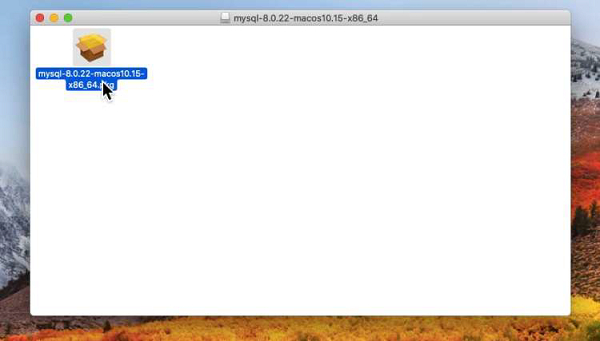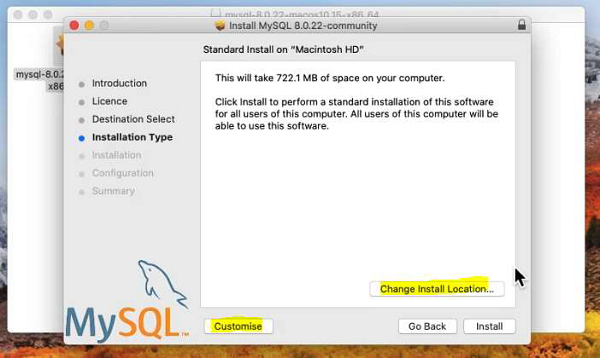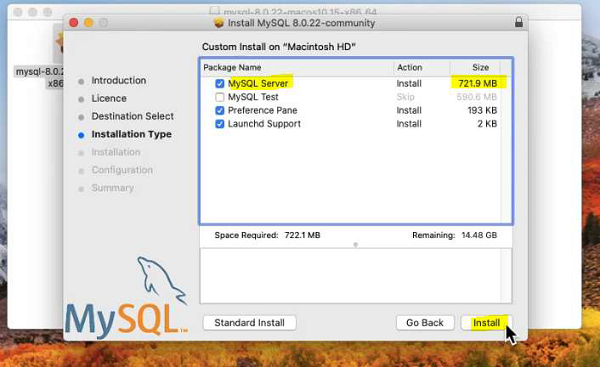Install MySQL on macOS
Let’s learn how to install MySQL on macOS.
There is a package located in a disk image (.dmg) file, which needs to be mounted by double-clicking the icon in Finder. The next step is to mount the image and display its contents.
Before installing MySQL, users must ensure that all MySQL server instances have stopped running. This can be done using the MySQL management application on the macOS server, the preference pane, or using mysqladmin shutdown on the command line.
MySQL can be installed using the package installer. Let's see how to do this.
Requires downloading a disk image (.dmg) file (a community version of which is also available). This will contain the MySQL package installer. Please refer to the official website screenshot below -

The MySQL installer package downloaded above is now on the disk and needs to be double-clicked .

Its name is based on the downloaded version of MySQL. If the MySQL server version is 8.0.22, the name will be mysql-8.0.22-osx-10.13-x86_64.pkg.
The initial wizard introduction screen is used to reference the MySQL server version that needs to be installed.
Click "Continue" to start installing the software package.
MySQL Community Edition also displays a copy of the relevant GNU General Public License.
Click "Continue" and then "Agree" to continue.
From the Installation Type page, users can click Install to execute the installation wizard with all defaults, or Customize to change the specific components that need to be installed (such as MySQL Server, MySQL Test, Preference Pane, Launchd Support - all enabled by default except MySQL Test).

The "Change installation location" option is available, but the installation location cannot be changed.
You must click "Install" to install the MySQL server.

If you are upgrading the current MySQL server installation, the installation process ends here, otherwise you need to follow the additional configuration of the wizard Steps to complete a new MySQL server installation.
After successfully installing the MySQL server, you need to complete the configuration steps by selecting the default encryption type for passwords and enabling or disabling the MySQL server.
The default MySQL 8.0 password mechanism uses caching_sha2_password (strong password).
This step also allows the user to change it to mysql_native_password (legacy password).
When the traditional password mechanism is selected, it modifies the generated launchd file to set --default_authentication_plugin = mysql_native_password under ProgramArguments.
Selecting strong password encryption will not set --default_authentication_plugin because the default MySQL server value is used, which is caching_sha2_password.
Define a password for the root user and toggle to know if the MySQL server starts after the configuration steps are completed.
Summary is the final step to reference a successful and complete MySQL server installation. The wizard must be closed.
MySQL server is finally installed.
If the user chooses not to start MySQL at startup, they can start MySQL using launchctl from the command line or using the "Launch" button of the MySQL preference pane.
When you complete the installation using the package installer, the files are installed into a directory in /usr/local that matches the installation version and platform name.
Let us take an example to understand this: the installer file is mysql-8.0.25-osx10.15-x86_64.dmg, which installs MySQL to /usr/local/mysql-8.0.25-osx10 .15-x86_64/ and create a symbolic link to
/usr/local/mysql. The macOS installation process does not create or install the sample my.cnf MySQL configuration file.The above is the detailed content of Install MySQL on macOS. For more information, please follow other related articles on the PHP Chinese website!

Hot AI Tools

Undresser.AI Undress
AI-powered app for creating realistic nude photos

AI Clothes Remover
Online AI tool for removing clothes from photos.

Undress AI Tool
Undress images for free

Clothoff.io
AI clothes remover

AI Hentai Generator
Generate AI Hentai for free.

Hot Article

Hot Tools

Notepad++7.3.1
Easy-to-use and free code editor

SublimeText3 Chinese version
Chinese version, very easy to use

Zend Studio 13.0.1
Powerful PHP integrated development environment

Dreamweaver CS6
Visual web development tools

SublimeText3 Mac version
God-level code editing software (SublimeText3)

Hot Topics
 1371
1371
 52
52
 How do you alter a table in MySQL using the ALTER TABLE statement?
Mar 19, 2025 pm 03:51 PM
How do you alter a table in MySQL using the ALTER TABLE statement?
Mar 19, 2025 pm 03:51 PM
The article discusses using MySQL's ALTER TABLE statement to modify tables, including adding/dropping columns, renaming tables/columns, and changing column data types.
 How do I configure SSL/TLS encryption for MySQL connections?
Mar 18, 2025 pm 12:01 PM
How do I configure SSL/TLS encryption for MySQL connections?
Mar 18, 2025 pm 12:01 PM
Article discusses configuring SSL/TLS encryption for MySQL, including certificate generation and verification. Main issue is using self-signed certificates' security implications.[Character count: 159]
 How do you handle large datasets in MySQL?
Mar 21, 2025 pm 12:15 PM
How do you handle large datasets in MySQL?
Mar 21, 2025 pm 12:15 PM
Article discusses strategies for handling large datasets in MySQL, including partitioning, sharding, indexing, and query optimization.
 What are some popular MySQL GUI tools (e.g., MySQL Workbench, phpMyAdmin)?
Mar 21, 2025 pm 06:28 PM
What are some popular MySQL GUI tools (e.g., MySQL Workbench, phpMyAdmin)?
Mar 21, 2025 pm 06:28 PM
Article discusses popular MySQL GUI tools like MySQL Workbench and phpMyAdmin, comparing their features and suitability for beginners and advanced users.[159 characters]
 How do you drop a table in MySQL using the DROP TABLE statement?
Mar 19, 2025 pm 03:52 PM
How do you drop a table in MySQL using the DROP TABLE statement?
Mar 19, 2025 pm 03:52 PM
The article discusses dropping tables in MySQL using the DROP TABLE statement, emphasizing precautions and risks. It highlights that the action is irreversible without backups, detailing recovery methods and potential production environment hazards.
 How do you represent relationships using foreign keys?
Mar 19, 2025 pm 03:48 PM
How do you represent relationships using foreign keys?
Mar 19, 2025 pm 03:48 PM
Article discusses using foreign keys to represent relationships in databases, focusing on best practices, data integrity, and common pitfalls to avoid.
 How do you create indexes on JSON columns?
Mar 21, 2025 pm 12:13 PM
How do you create indexes on JSON columns?
Mar 21, 2025 pm 12:13 PM
The article discusses creating indexes on JSON columns in various databases like PostgreSQL, MySQL, and MongoDB to enhance query performance. It explains the syntax and benefits of indexing specific JSON paths, and lists supported database systems.
 How do I secure MySQL against common vulnerabilities (SQL injection, brute-force attacks)?
Mar 18, 2025 pm 12:00 PM
How do I secure MySQL against common vulnerabilities (SQL injection, brute-force attacks)?
Mar 18, 2025 pm 12:00 PM
Article discusses securing MySQL against SQL injection and brute-force attacks using prepared statements, input validation, and strong password policies.(159 characters)




